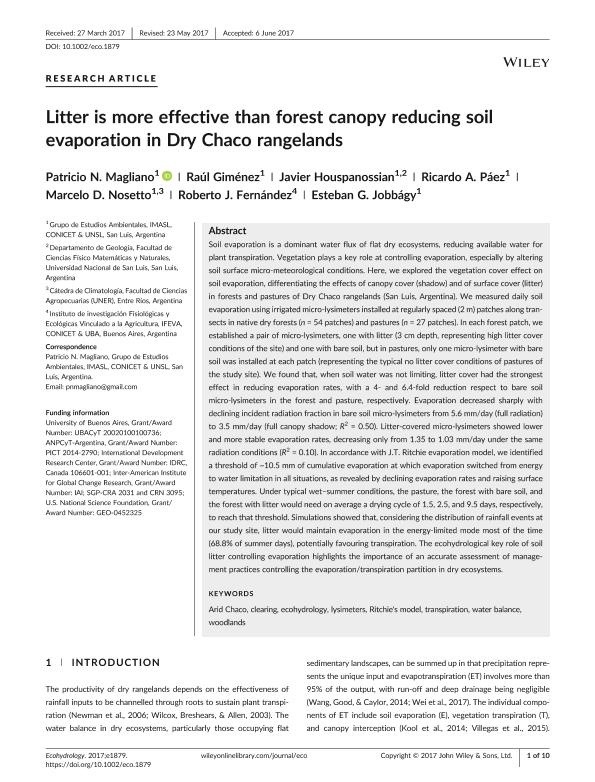Mostrar el registro sencillo del ítem
dc.contributor.author
Magliano, Patricio Nicolás

dc.contributor.author
Giménez, Raúl

dc.contributor.author
Houspanossian, Javier

dc.contributor.author
Paez, Ricardo Andrés

dc.contributor.author
Nosetto, Marcelo Daniel

dc.contributor.author
Fernandez Alduncin, Roberto Javier

dc.contributor.author
Jobbagy Gampel, Esteban Gabriel

dc.date.available
2018-11-27T15:15:44Z
dc.date.issued
2017-10
dc.identifier.citation
Magliano, Patricio Nicolás; Giménez, Raúl; Houspanossian, Javier; Paez, Ricardo Andrés; Nosetto, Marcelo Daniel; et al.; Litter is more effective than forest canopy reducing soil evaporation in Dry Chaco rangelands; John Wiley & Sons Inc; Ecohydrology; 10; 7; 10-2017; 1-10; e1879
dc.identifier.issn
1936-0584
dc.identifier.uri
http://hdl.handle.net/11336/65310
dc.description.abstract
Soil evaporation is a dominant water flux of flat dry ecosystems, reducing available water for plant transpiration. Vegetation plays a key role at controlling evaporation, especially by altering soil surface micro-meteorological conditions. Here, we explored the vegetation cover effect on soil evaporation, differentiating the effects of canopy cover (shadow) and of surface cover (litter) in forests and pastures of Dry Chaco rangelands (San Luis, Argentina). We measured daily soil evaporation using irrigated micro-lysimeters installed at regularly spaced (2 m) patches along transects in native dry forests (n = 54 patches) and pastures (n = 27 patches). In each forest patch, we established a pair of micro-lysimeters, one with litter (3 cm depth, representing high litter cover conditions of the site) and one with bare soil, but in pastures, only one micro-lysimeter with bare soil was installed at each patch (representing the typical no litter cover conditions of pastures of the study site). We found that, when soil water was not limiting, litter cover had the strongest effect in reducing evaporation rates, with a 4- and 6.4-fold reduction respect to bare soil micro-lysimeters in the forest and pasture, respectively. Evaporation decreased sharply with declining incident radiation fraction in bare soil micro-lysimeters from 5.6 mm/day (full radiation) to 3.5 mm/day (full canopy shadow; R2 = 0.50). Litter-covered micro-lysimeters showed lower and more stable evaporation rates, decreasing only from 1.35 to 1.03 mm/day under the same radiation conditions (R2 = 0.10). In accordance with J.T. Ritchie evaporation model, we identified a threshold of ~10.5 mm of cumulative evaporation at which evaporation switched from energy to water limitation in all situations, as revealed by declining evaporation rates and raising surface temperatures. Under typical wet–summer conditions, the pasture, the forest with bare soil, and the forest with litter would need on average a drying cycle of 1.5, 2.5, and 9.5 days, respectively, to reach that threshold. Simulations showed that, considering the distribution of rainfall events at our study site, litter would maintain evaporation in the energy-limited mode most of the time (68.8% of summer days), potentially favouring transpiration. The ecohydrological key role of soil litter controlling evaporation highlights the importance of an accurate assessment of management practices controlling the evaporation/transpiration partition in dry ecosystems.
dc.format
application/pdf
dc.language.iso
eng
dc.publisher
John Wiley & Sons Inc

dc.rights
info:eu-repo/semantics/openAccess
dc.rights.uri
https://creativecommons.org/licenses/by-nc-sa/2.5/ar/
dc.subject
Arid Chaco
dc.subject
Clearing
dc.subject
Ecohydrology
dc.subject
Lysimeters
dc.subject
Ritchie'S Model
dc.subject
Transpiration
dc.subject
Water Balance
dc.subject
Woodlands
dc.subject.classification
Ciencias Medioambientales

dc.subject.classification
Ciencias de la Tierra y relacionadas con el Medio Ambiente

dc.subject.classification
CIENCIAS NATURALES Y EXACTAS

dc.subject.classification
Oceanografía, Hidrología, Recursos Hídricos

dc.subject.classification
Ciencias de la Tierra y relacionadas con el Medio Ambiente

dc.subject.classification
CIENCIAS NATURALES Y EXACTAS

dc.title
Litter is more effective than forest canopy reducing soil evaporation in Dry Chaco rangelands
dc.type
info:eu-repo/semantics/article
dc.type
info:ar-repo/semantics/artículo
dc.type
info:eu-repo/semantics/publishedVersion
dc.date.updated
2018-10-23T17:40:59Z
dc.journal.volume
10
dc.journal.number
7
dc.journal.pagination
1-10; e1879
dc.journal.pais
Estados Unidos

dc.description.fil
Fil: Magliano, Patricio Nicolás. Consejo Nacional de Investigaciones Científicas y Técnicas. Centro Científico Tecnológico Conicet - San Luis. Instituto de Matemática Aplicada de San Luis ; Argentina
dc.description.fil
Fil: Giménez, Raúl. Consejo Nacional de Investigaciones Científicas y Técnicas. Centro Científico Tecnológico Conicet - San Luis. Instituto de Matemática Aplicada de San Luis ; Argentina
dc.description.fil
Fil: Houspanossian, Javier. Consejo Nacional de Investigaciones Científicas y Técnicas. Centro Científico Tecnológico Conicet - San Luis. Instituto de Matemática Aplicada de San Luis ; Argentina
dc.description.fil
Fil: Paez, Ricardo Andrés. Consejo Nacional de Investigaciones Científicas y Técnicas. Centro Científico Tecnológico Conicet - San Luis. Instituto de Matemática Aplicada de San Luis ; Argentina
dc.description.fil
Fil: Nosetto, Marcelo Daniel. Consejo Nacional de Investigaciones Científicas y Técnicas. Centro Científico Tecnológico Conicet - San Luis. Instituto de Matemática Aplicada de San Luis ; Argentina
dc.description.fil
Fil: Fernandez Alduncin, Roberto Javier. Consejo Nacional de Investigaciones Científicas y Técnicas. Oficina de Coordinación Administrativa Parque Centenario. Instituto de Investigaciones Fisiológicas y Ecológicas Vinculadas a la Agricultura. Universidad de Buenos Aires. Facultad de Agronomía; Argentina
dc.description.fil
Fil: Jobbagy Gampel, Esteban Gabriel. Consejo Nacional de Investigaciones Científicas y Técnicas. Centro Científico Tecnológico Conicet - San Luis. Instituto de Matemática Aplicada de San Luis ; Argentina
dc.journal.title
Ecohydrology

dc.relation.alternativeid
info:eu-repo/semantics/altIdentifier/url/https://onlinelibrary.wiley.com/doi/abs/10.1002/eco.1879
dc.relation.alternativeid
info:eu-repo/semantics/altIdentifier/doi/http://dx.doi.org/10.1002/eco.1879
Archivos asociados
